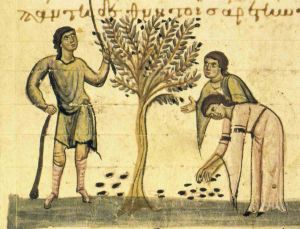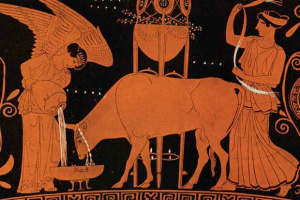Language/Ancient-greek-to-1453/Culture/Fruits
Hi Ancient Greek learners! 😊
In this lesson, we will learn some cultural facts related to fruits in Ancient Greek. Fruits have always played an important role in Ancient Greek culture and mythology.
The Greeks relished both fresh and dried fruits, which grew naturally on trees such as pears, mulberries, cherries, and apples. They also had access to plums, damsons, bullaces, blackberries, and various wild berries. Figs, raisins, and dates were commonly consumed, while pomegranates were imported from Cyprus and other Greek islands. Numerous grape varieties were sourced from across Greece. The strawberry tree, also known as the Arbutus, produced delicious red berries when ripe. Melons and peaches were highly favored, as were quinces, especially those from the island of Cos. The Royal Nut, or walnut, was widely cultivated in Greece and its colonies, along with beech nuts, chestnuts, pine-kernels, and almonds.
The olive, however, held a special place in Greek cuisine. According to legend, Athena, the Goddess of Wisdom and Protector of Cities, gifted the olive tree to Athens, from where it spread throughout Greece. In addition to being a foodstuff, olives were also pressed to extract oil. This oil served as the sole fuel for clay or metal lamps, emitting a gentle, clear flame.
➡ If you have any questions, please ask them in the comments section below.
➡ Feel free to edit this wiki page if you think it can be improved. 😎
Consider broadening your understanding by checking out these related lessons: Greek Philosopher quotes & Timeline of ancient Greece.
Sources[edit | edit source]
Other Lessons[edit | edit source]
- Ancient Greece Timeline
- Ancient Greek first names for tattoos
- Ode to Love
- Ancient Greek Diplomacy
- Shield of Achilles
- Pindar Poem
- Battle of Thermopylae
- Thespis the father of dramatic art
- Gamos – Marriage
- Linear B


